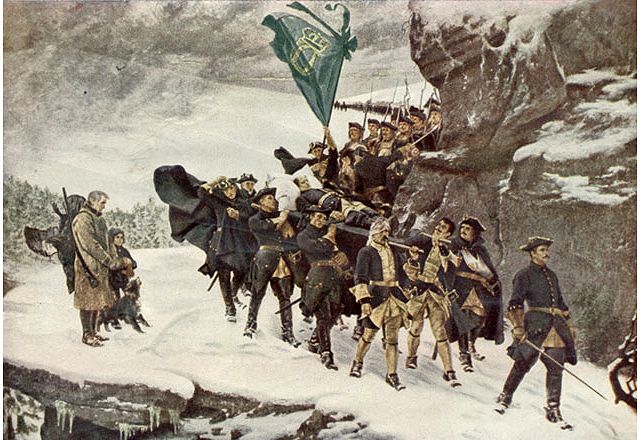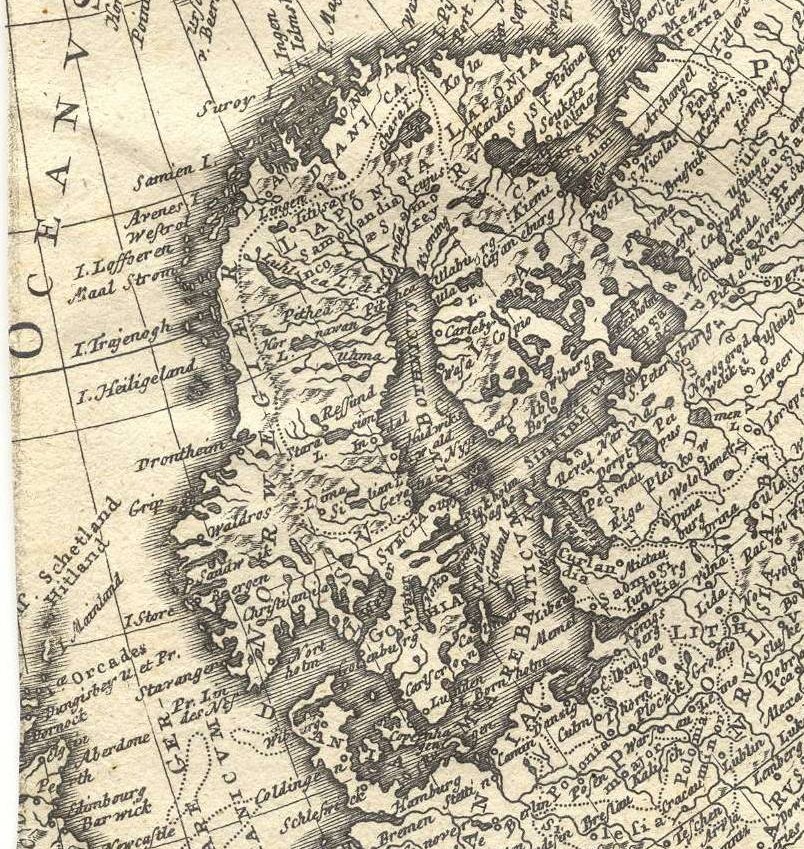


The Scandinavian peninsula. GOTHIA and SVECIA as well as Gothenburg are indicated.
Top left corner section from a map "Asia Secundum legitimas Projectionis..." M August Gottlob Boehmio 1744.
10 000 years ago, the land was covered with ice. When the ice melted, the Scandinavian peninsula slowly rose from the sea. It's climate and resources were very different depending on region.
One people called "Svear" settled in the middle of Sweden. They were farmers and hunters and traded over the Baltic Sea with Finland and Russia. Their capital became Stockholm.
The south of Sweden became the land of the "Goths". They lived secluded for a long time but many important impulses from Europe entered Scandinavia through them.
In the north of Sweden, the inhabitants depended largely on small farming, hunting and fishing because of the cold climate. In modern times its large supply of ore, forests and water power have given a substantial contribution to the Swedish economy.
The merging of these tribes for mutual defence and the development of trade formed the country of Sweden.
During the seventh and eighth centuries, the Swedes were merchant seamen well known for their far-reaching trade. In the ninth century, Nordic Vikings raided and ravaged the European continent as far as the Black and Caspian Seas. During the 11th and 12th centuries, Sweden gradually became a unified Christian kingdom that later included Finland.

In 1718 the Swedish King Charles XII was shot outside the fortress of Frederikshald,
and the Swedish era of Great Power was ended with the unfavourable peace treatises that followed.
Fictional painting by Gustaf Cederström, 1884.
Although the young Swedish king Charles XII won spectacular victories in the early years of the Great Northern War, his plan to attack Moscow and force Russia into peace proved too ambitious; he fell in battle in 1718. In the subsequent peace treaties, Sweden suffered great territorial losses. Sweden's reign as a great power had ended.
In the early 18th century, after almost a hundred years of war with neighbouring countries, the Swedish economy was in ruins. Sweden needed a new beginning. Peaceful contacts with Europe and the rest of the world were intensified. The city of Gothenburg on the west coast of Sweden became instrumental in this. Among other new approaches, the decision was made to develop international trade with China. The successful English and Dutch East India companies already trading were closely studied.
During the 19th century, Sweden gradually industrialised.
On March 20, 1847, a treaty of Peace, Amity and Commerce was signed between the Kingdom of Sweden and the Chinese Empire and already in 1863, a Swedish Consulate General was opened in Shanghai and about 20 years later, in 1869, the Suez channel was opened for traffic. With this, China was brought 5000 kilometres closer to Europe.
In 1907 the "Svenska Ostasiatiska Kompaniet" again established a regular shipping line between Sweden and China.
Since 1814 Sweden has not been involved in any war and has during the major part of this period pursued a foreign policy of non-alignment in peacetime and neutrality in wartime. The end of the political division of Europe has in the 1990s created new perspectives for Sweden and new opportunities to participate in the process of European integration.
On January 1, l995, Sweden became a member of the European Union (EU).
Sweden is the largest economy in Scandinavia and located at the crossroads of the emerging Baltic markets and the European Union in the northern Europe. Sweden has a solid industrial tradition and offers one of the world's most efficient infrastructures. This applies particularly to telecommunications and information technology.
Its area is 449,964 sq. km of which about 10% is water. With a population of 9 million (2005) Sweden is densely populated with only 21 persons per square kilometres in average. Of the population of 9 million people one-eighth of the population - or more than 1 million - are either foreign born or children of immigrants. As a comparison, due to large emigration to the USA by the end of the 19th century nearly 14 million Americans today are of Swedish descent. Ethnic and linguistic minorities include 15,000 Lapps and 50,000 indigenous Finnish speakers in the north.
Sweden is an industrial country where agriculture now employs less than 3% of the labour force. Sweden has one of the world's highest life expectancies and one of the lowest birth rates. Average life expectancy in Sweden has grown from 40 years in 1850 and 55 years in 1900 to 79 years for men and 84 years for women by 1995.
The language is Swedish with English as the leading foreign second language spoken or well understood by a large majority of the population.
Religion: Lutheran (87%), with minorities of Catholic, Orthodox, Baptist, Muslim, Jewish and Buddhist confession.
Education: Compulsory: 9 years.
Government type: Constitutional monarchy
Currency: 1 Krona (crown) SEK = 100 öre.
Exchange rate 1 SEK = 1,05 RMB
National day: June 6th
This text was prepared by Bengt Johansson, Jan-Erik Nilsson, and Anders Wästfelt for an exhibition that were to be held in Shanghai. The purpose was to give a general background to 18th century Sweden and to connect Sweden with modern China throughout history - by peaceful trade - and then put the ongoing Gotheborg III project in the middle of the ongoing Swedish-Chinese world trade development. I was very much aware of what kind of forces we were setting in motion.